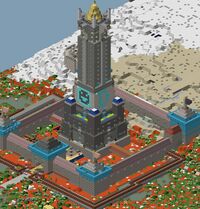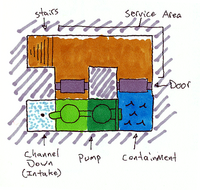- v50 information can now be added to pages in the main namespace. v0.47 information can still be found in the DF2014 namespace. See here for more details on the new versioning policy.
- Use this page to report any issues related to the migration.
Difference between revisions of "Tower (project)"
m (Interwiki link) |
(+construction) |
||
| Line 10: | Line 10: | ||
As a player construction, a large tower can serve the same role as a below-ground fortress, but without the drawbacks of [[cave adaptation]]: all of its tiles being [[Tile attributes|Light Above Ground]], so the dwarves will always be exposed to sunlight. However, it takes a large amount of resources (usually [[stone]] or [[wood]]) to construct a tower; while a source of [[clay]] or [[glass|green glass]] can alleviate this, it is still much less efficient than carving out a fortress entirely beneath the earth. | As a player construction, a large tower can serve the same role as a below-ground fortress, but without the drawbacks of [[cave adaptation]]: all of its tiles being [[Tile attributes|Light Above Ground]], so the dwarves will always be exposed to sunlight. However, it takes a large amount of resources (usually [[stone]] or [[wood]]) to construct a tower; while a source of [[clay]] or [[glass|green glass]] can alleviate this, it is still much less efficient than carving out a fortress entirely beneath the earth. | ||
| − | Usually, a tower is built from [[Construction|constructed]] [[wall]]s, [[floor]]s, and [[stairs]], although on some levels (such as those being used for the [[barracks]]) walls may be carved into or replaced by [[fortification]]s. With sufficient planning, a tower can also be cast from [[obsidian]]. | + | Usually, a tower is built from [[Construction|constructed]] [[wall]]s, [[floor]]s, and [[stairs]], although on some levels (such as those being used for the [[barracks]]) walls may be carved into or replaced by [[fortification]]s. With sufficient planning, a tower can also be cast from [[obsidian]] or, in an appropriate [[biome]], [[ice]]. |
| + | |||
| + | === Construction === | ||
| + | |||
| + | Because dwarves require an orthogonally adjacent tile to construct walls, creating a multi-z-level wall can be a logistical challenge. It is possible to use the floors provided by the lower level walls to construct the next level, though this requires staggering construction designations to build the walls farthest from an access point first. If you have an abundance of material (and plan to build floors on the inside anyway), you can use the implied floors from the walls below to construct an inner ring of floors, then use those floors to construct an outer ring of walls. Less resource-intensive temporary access can be provided by building one-tile-wide [[bridge]]s as "scaffolds" around the interior. | ||
| + | |||
| + | Alternatively, staggering the tower walls can simplify construction: | ||
| + | |||
| + | <diagram> | ||
| + | |||
| + | z z + 1 z + 2 | ||
| + | ........... | ||
| + | .╔═══════╗. +++++++++ ╔═════╗ | ||
| + | .║.......║. +╔═════╗+ ╔[#f00]╝[#]+++++[#f00]╚[#]╗ | ||
| + | .║.......║. +║ ║+ ║+ +║ | ||
| + | .║.......║. +║ ║+ ║+ +║ | ||
| + | .║...X...║. +║ X ║+ ║+ X +║ | ||
| + | .║...O...║. +╚══[#f00]═[#]══╝+ ╚[#f00]╗[#]++[#f00]O[#]++[#f00]╔[#]╝ | ||
| + | .╚══O.O══╝. +++++++++ ╚══╩══╝ | ||
| + | ........... | ||
| + | |||
| + | . ground | ||
| + | ═ wall | ||
| + | X stairs | ||
| + | + floor provided by wall below | ||
| + | [#f00]═[#] wall built last | ||
| + | </diagram> | ||
| + | |||
| + | This design lets you designate (almost) an entire level at a time using large swaths, allows multiple builders to work simultaneously without problems, uses fewer blocks and jobs, and requires no slow remove-construction jobs. It can be continued higher by alternating the top two levels. | ||
{{Category|Design}} | {{Category|Design}} | ||
[[ru:Tower (project)]] | [[ru:Tower (project)]] | ||
Revision as of 20:32, 22 April 2019
| Part of a number of articles on |
| Projects |
|---|
| Basic |
| Aqueduct • Archery tower • Atom smasher • Danger room • Dam • Garbage dump • Mass pit • Moat • Pit trap • Reservoir• Sally port • Swimming pool • Tower • Tree farm |
| Advanced |
| Drowning chamber • Magma piston • Obsidian farm • Pump stack • Silk farm • Water reactor |
v50.12 · v0.47.05 This article is about the current version of DF.Note that some content may still need to be updated. |
- Not to be confused with necromancer's towers.
A tower is any vertical structure consisting of multiple levels of a similar shape stacked on top of each other, often connected by stairs.

As a player construction, a large tower can serve the same role as a below-ground fortress, but without the drawbacks of cave adaptation: all of its tiles being Light Above Ground, so the dwarves will always be exposed to sunlight. However, it takes a large amount of resources (usually stone or wood) to construct a tower; while a source of clay or green glass can alleviate this, it is still much less efficient than carving out a fortress entirely beneath the earth.
Usually, a tower is built from constructed walls, floors, and stairs, although on some levels (such as those being used for the barracks) walls may be carved into or replaced by fortifications. With sufficient planning, a tower can also be cast from obsidian or, in an appropriate biome, ice.
Construction
Because dwarves require an orthogonally adjacent tile to construct walls, creating a multi-z-level wall can be a logistical challenge. It is possible to use the floors provided by the lower level walls to construct the next level, though this requires staggering construction designations to build the walls farthest from an access point first. If you have an abundance of material (and plan to build floors on the inside anyway), you can use the implied floors from the walls below to construct an inner ring of floors, then use those floors to construct an outer ring of walls. Less resource-intensive temporary access can be provided by building one-tile-wide bridges as "scaffolds" around the interior.
Alternatively, staggering the tower walls can simplify construction:
| z | z | + | 1 | z | + | 2 | ||||||||||||||||||||||||||||||||||||||
| . | . | . | . | . | . | . | . | . | . | . | ||||||||||||||||||||||||||||||||||
| . | ╔ | ═ | ═ | ═ | ═ | ═ | ═ | ═ | ╗ | . | + | + | + | + | + | + | + | + | + | ╔ | ═ | ═ | ═ | ═ | ═ | ╗ | ||||||||||||||||||
| . | ║ | . | . | . | . | . | . | . | ║ | . | + | ╔ | ═ | ═ | ═ | ═ | ═ | ╗ | + | ╔ | ╝ | + | + | + | + | + | ╚ | ╗ | ||||||||||||||||
| . | ║ | . | . | . | . | . | . | . | ║ | . | + | ║ | ║ | + | ║ | + | + | ║ | ||||||||||||||||||||||||||
| . | ║ | . | . | . | . | . | . | . | ║ | . | + | ║ | ║ | + | ║ | + | + | ║ | ||||||||||||||||||||||||||
| . | ║ | . | . | . | X | . | . | . | ║ | . | + | ║ | X | ║ | + | ║ | + | X | + | ║ | ||||||||||||||||||||||||
| . | ║ | . | . | . | O | . | . | . | ║ | . | + | ╚ | ═ | ═ | ═ | ═ | ═ | ╝ | + | ╚ | ╗ | + | + | O | + | + | ╔ | ╝ | ||||||||||||||||
| . | ╚ | ═ | ═ | O | . | O | ═ | ═ | ╝ | . | + | + | + | + | + | + | + | + | + | ╚ | ═ | ═ | ╩ | ═ | ═ | ╝ | ||||||||||||||||||
| . | . | . | . | . | . | . | . | . | . | . | ||||||||||||||||||||||||||||||||||
| . | g | r | o | u | n | d | ||||||||||||||||||||||||||||||||||||||
| ═ | w | a | l | l | ||||||||||||||||||||||||||||||||||||||||
| X | s | t | a | i | r | s | ||||||||||||||||||||||||||||||||||||||
| + | f | l | o | o | r | p | r | o | v | i | d | e | d | b | y | w | a | l | l | b | e | l | o | w | ||||||||||||||||||||
| ═ | w | a | l | l | b | u | i | l | t | l | a | s | t |
This design lets you designate (almost) an entire level at a time using large swaths, allows multiple builders to work simultaneously without problems, uses fewer blocks and jobs, and requires no slow remove-construction jobs. It can be continued higher by alternating the top two levels.
